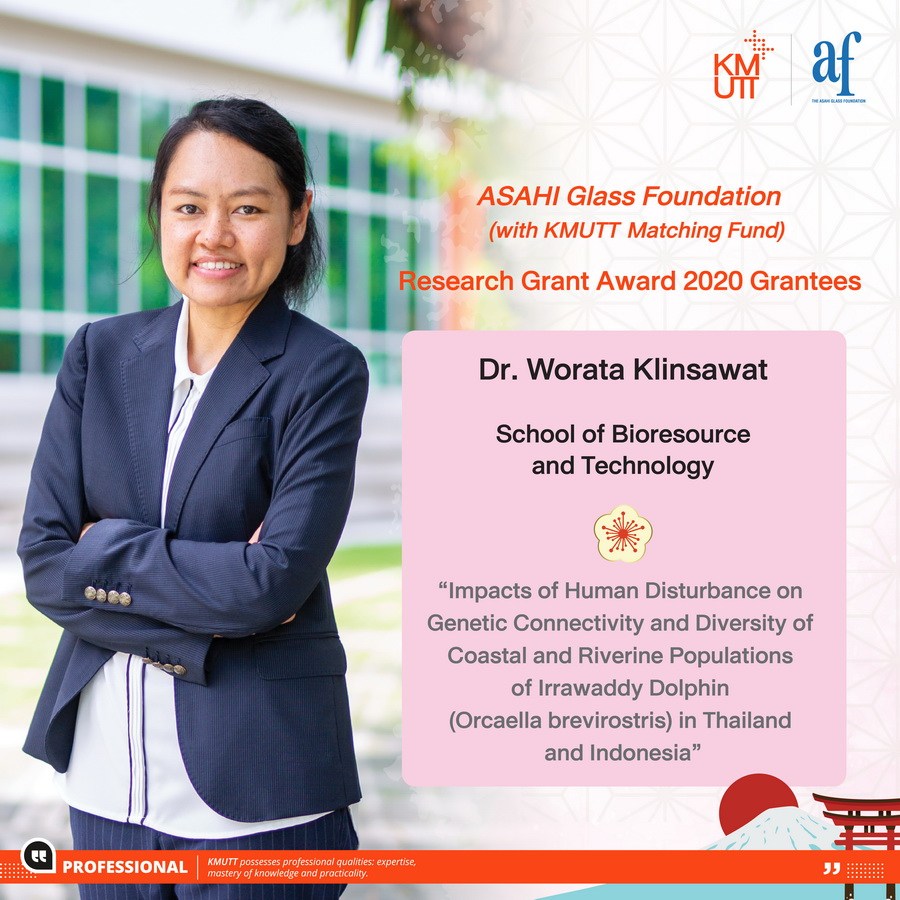
Principle Investigator: Dr. Worata Klinsawat
School of Bioresources and Technology
Project Title: Impacts of human disturbance on genetic connectivity and diversity of coastal and riverine populations of Irrawaddy Dolphin (Orcaella brevirostris) in Thailand and Indonesia
Abstract of Proposal
Southeast Asia is one of the global hotspots for freshwater and marine diversity. Large-scale land use changes and deteriorating freshwater quality are rapidly threatening the ecosystem function and driving biodiversity loss across the riverine and coastal habitat. Populations of Irrawaddy dolphin in Thailand and Indonesia are drastically declined and listed as Critically Endangered. As a top predator of the freshwater ecosystems, the loss of Irrawaddy dolphin will negatively alter ecosystem structure, which may have repercussions toward human health and well-being. However, impacts of human disturbance on their population dynamics remain unknown. Advances in molecular techniques have enabled rapid and reliable assessment of population genetic structure and diversity. Here we will apply population genetics to disentangle impacts of geological events from recent human-induced fragmentation on gene flow and genetic diversity of Irrawaddy Dolphin populations in Thailand and Indonesia. This research provides baseline data on demography, population connectivity and highlights the potential of genetic monitoring to inform management actions needed to ensure population viability and species persistence.
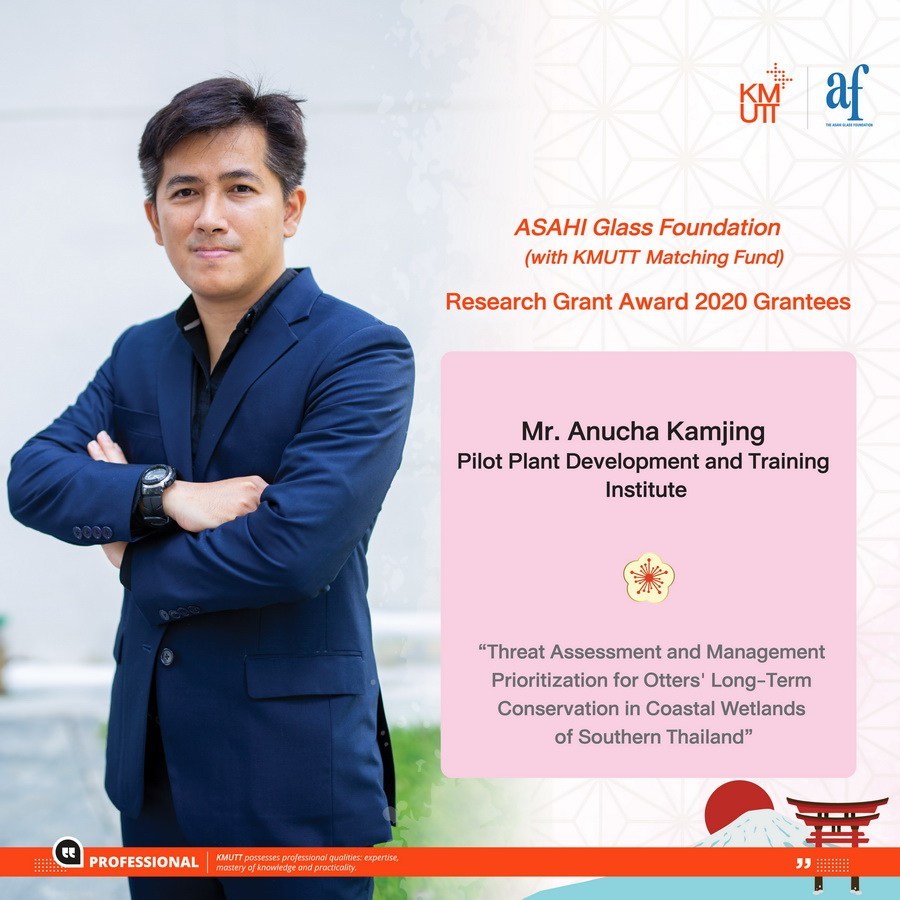
Principle Investigator: Mr. Anucha Kamjing
Pilot Plant Development and Training Institute
Project Title: Threat assessment and management prioritization for otters’ long–term conservation in coastal wetlands of southern Thailand.
Abstract of Proposal
Conservation management of otters in coastal wetland of southern Thailand is still challenging. Currently, distribution data of two otter species in landscape level has already been available; however, to achieve effective management for long-term conservation, information in both human and wildlife dimensions are needed. This project has objectives to (1) assess threat toward otter survival in coastal wetlands in southern Thailand, and (2) identify management schemes and urgency of each area. Group interviews will be conducted in key districts of four provinces of southern Thailand to identify threats and their severities in each area. Interview data will then be digitized and interpolated to produce threat maps, which then will be overlaid with otter occupancy maps to identify management for each land. The result from this project will lead to effective landuse management planning of which both human and wildlife can gain benefit, that human can minimize their economic loss while wildlife can ensure their long-term survival.
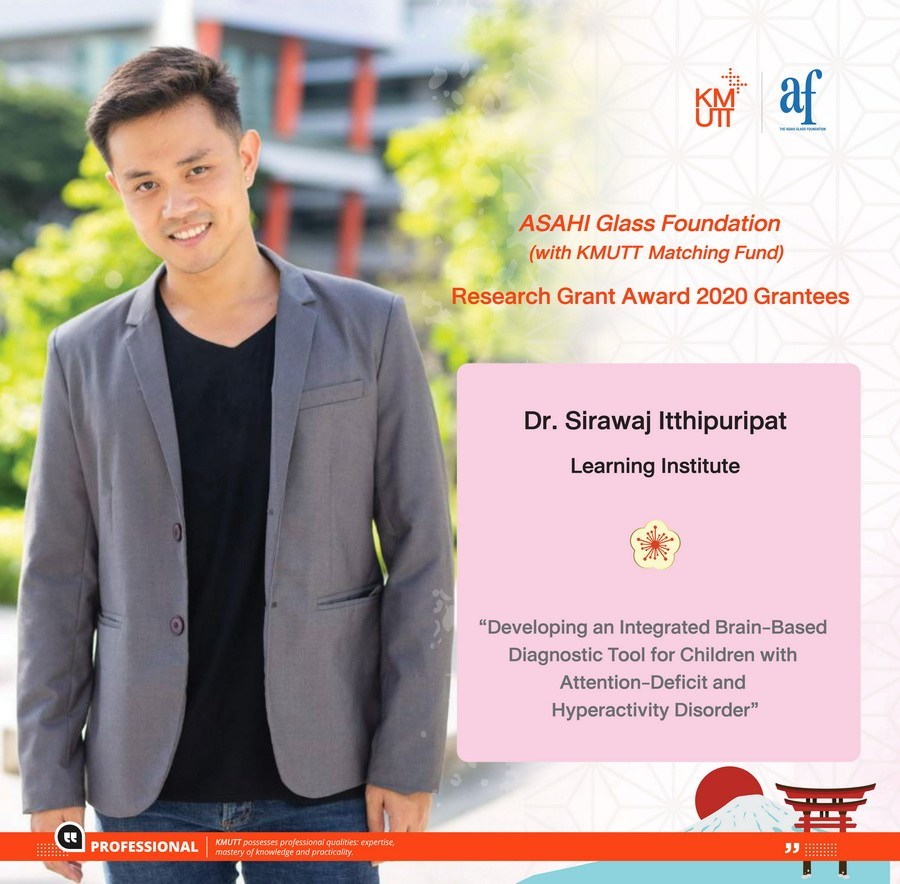
Principle Investigator: Dr. Sirawaj Itthipuripat
Learning Institute
Project Title: Developing an integrated brain–based diagnostic tool for children with attention–deficit and hyperactivity disorder
Abstract of Proposal
Attention-deficit hyperactivity disorder (ADHD) is one of the most prevalent neurodevelopmental disorders, where individuals cannot pay attention (i.e., inattention) and/or control their behaviors (i.e., hyperactivity and impulsivity). Early diagnosis can help prevent the progress of ADHD symptoms before children reach adulthood. However, ADHD children who are predominantly inattentive are often left unnoticed because they may not exhibit hyperactivity and impulsivity, which are relatively more noticeable to their parents and teachers. Here, we aim to develop an integrated brain-based diagnostic tool that uses eye movements and brain waves to index changes in neural processes that support value-driven attention in children with and without ADHD. Ultimately, we will use knowledge obtained from this research program to develop a brain-based wearable device that interfaces with a mobile/web application that could be easily deployed at home and hospital setting in order to help detect an early onset of attention deficits in ADHD.
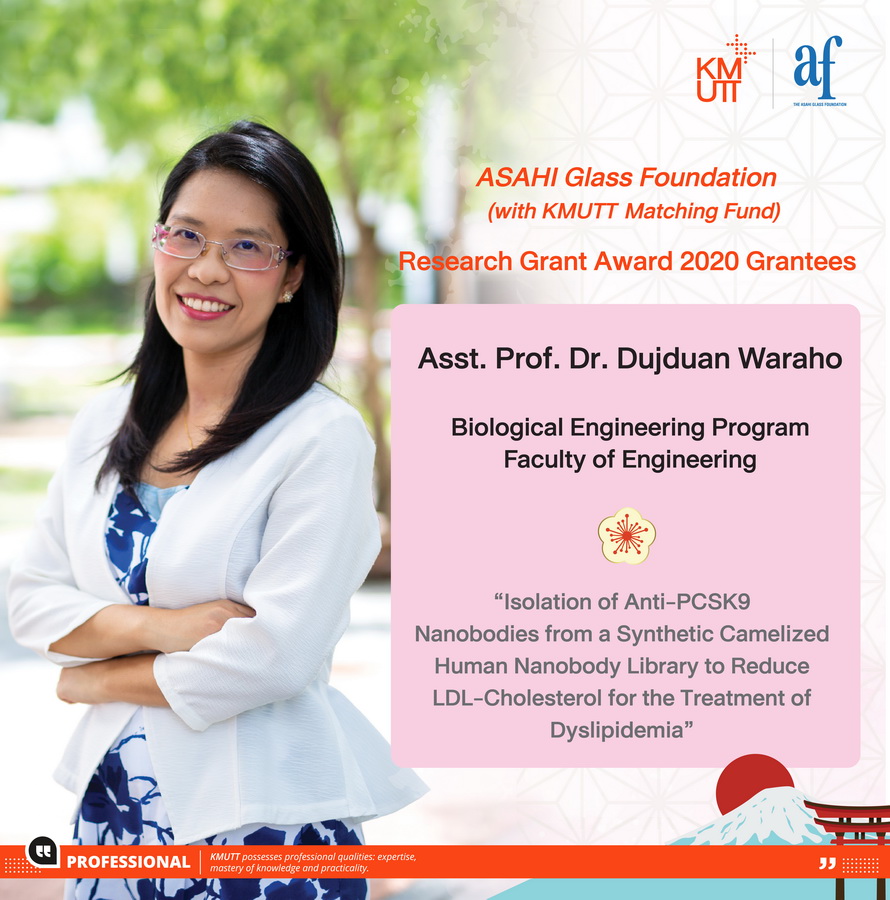
Principle Investigator: Asst.Prof.Dr.Dujduan Waraho
Biological Engineering Program, Faculty of Engineering
Project Title: Isolation of anti–PCSK9 nanobodies from a synthetic camelized human nanobody library to reduce LDL–cholesterol for the treatment of dyslipidemia
Abstract of Proposal
Dyslipidemia is an abnormal amount of lipids in the blood and is an important risk factor for cardiovascular disease, which causes nearly 2.6 million deaths worldwide. Statins are used for LDL-cholesterol reduction, but some patients are intolerant of statins due to its side effects. Proprotein convertase subtilisin/kexin type 9 (PCSK9) is a circulating protein that regulates plasma levels of low density lipoprotein cholesterol. Monoclonal antibodies (mAbs) have been extensively used for therapeutics for many decades and, currently, anti-PCSK9 mAbs are also available for dyslipidemia treatment. We aim to develop new anti-PCSK9 based on nanobody, the smallest unit of antibody fragment that remains the binding efficiency. mAbs are very costly as they need mammalian cells for production. Nanobodies can offer a better alternative as they can be produced in E. coli cells. Development of new biopharmaceuticals has been included in the “Thailand 4.0” economic model for which Medical Hub is one of ten key strategic growth engines. Therefore, nanobody drugs with affordable prices will be beneficial in large-scale socioeconomy.
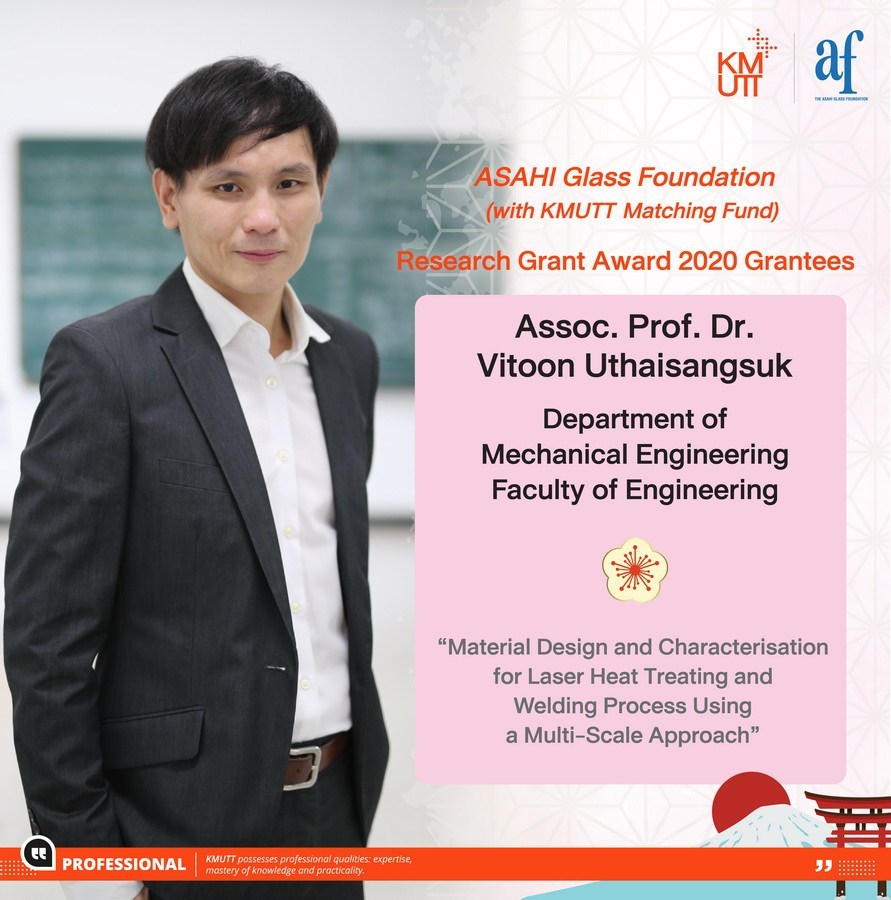
Principle Investigator: Assoc. Prof. Dr. Vitoon Uthaisangsuk
Department of Mechanical Engineering, Faculty of Engineering
Project Title: Material design and characterisation for laser heat treating and welding process using a multi–scale approach
Abstract of Proposal
The use of high strength steels in the automotive industry has been increasing year by year with the aspect of lighting the weight of vehicle. On the other hand, there exist many challenges for manufacturers to deal with the high strength steel grades due to limitations of their formability and workability. Our research works focus on applying laser technique to improve the formability of materials by means of local heat treatment and to join dissimilar materials. For local laser heating process, dual phase (DP) steel grade is examined, in which a short-time laser tempering will be applied to enhance the ductility of material. The change in microstructures of heat-treated samples will be observed by OM and SEM and resulted mechanical properties are studied by tensile testing. A correlation between desirable mechanical properties and laser heat treating parameters will be done. Subsequently, FE simulations of both quasi-static test and axial drop test are carried out for crash box samples with rectangular profile, which exhibit different patterns of locally heated zones. The determined crashworthiness will be validated with experimental result. For laser welding process with dissimilar metals, the influence of heat input and traveling speed on the weld bead dimension, microstructural and mechanical properties of the joints will be studied. The main purpose of this research is to characterize the intermetallic compound (IMC) formation and to understand the formation of IMC interlayers which are responsible for the failure of laser welded joints. A multi-scale modelling will be done to predict the mechanical and failure behavior of the welded joints.
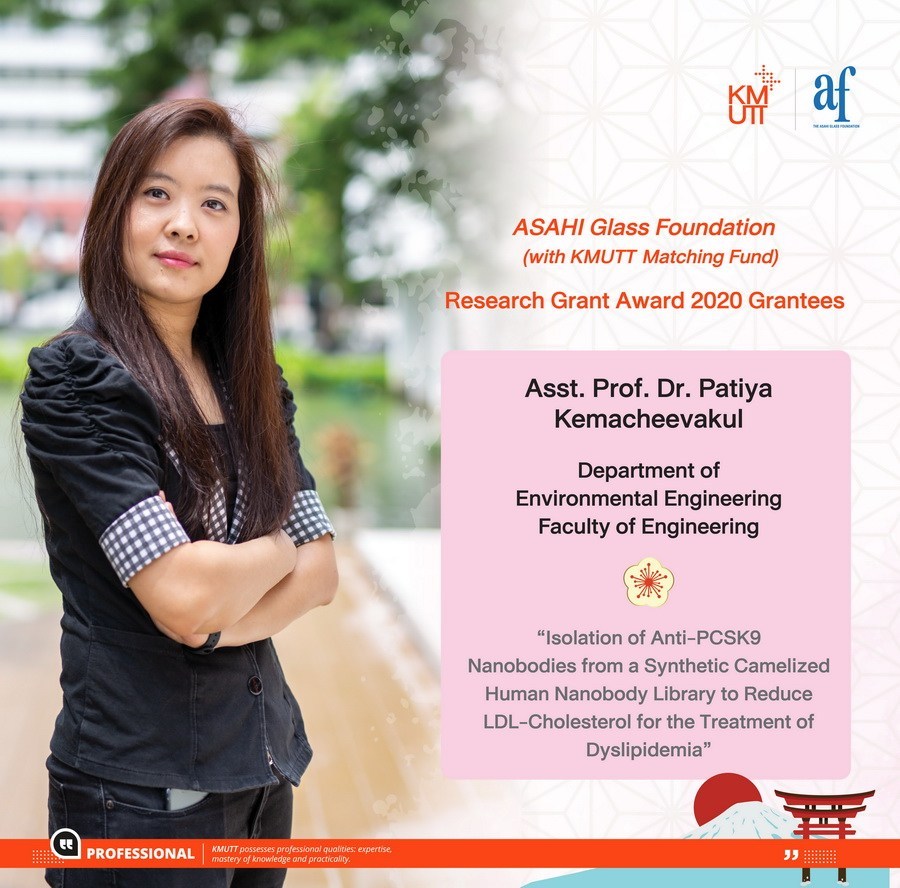
Principle Investigator: Asst.Prof.Dr. Patiya Kemacheevakul
Department of Environmental Engineering, Faculty of Engineering
Project Title: Photocatalytic Degradation of Hazardous Volatile Organic Compound using an Innovative Reactor with Nitrogen–doped Photocalayst–Coated Glass Sheets Under Visible and Solar Light Irradiations
Abstract of Proposal
Air pollution is a serious problem in the world. Benzene is well known as a hazardous volatile organic compound (VOC), which has been detected at a high level in indoor air. Therefore, we have a high chance to exposure to benzene in the buildings. Photocatalysis has attracted great attention for air treatment because other methods have the high cost and energy consumption. Thus, in this research, photocatalysts will be developed to mitigate these problems. N-doped TiO2 thin film coated glass sheets were prepared through a thermoplastic polymer modified sol-gel synthesis method coupled with the doctor blade coating technique. The coated substrates will be used to fabricate an innovative photocatalytic reactor for benzene removal under visible and solar light irradiations. The developed photocatalysts can be applied on the surface of glass windows or doors in the buildings, which can be removed VOCs in the air and can also be reused over and over again. Moreover, they can be used under solar irradiation (a free energy source) or visible lights which normally use in the buildings (no extra energy source).
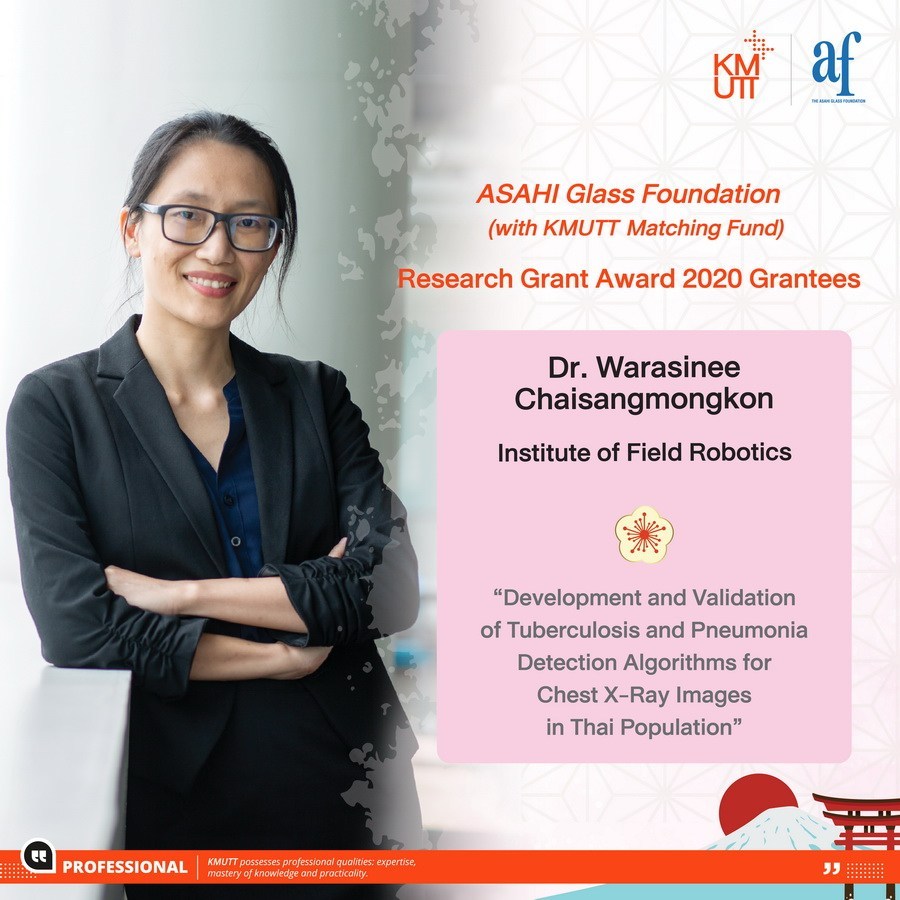
Principle Investigator: Dr. Warasinee Chaisangmongkon
Institute of Field Robotics
Project Title: Development and Validation Tuberculosis and Pneumonia Detection Algorithms for Chest X–ray Images in Thai Population
Abstract of Proposal
Tuberculosis (TB) and Pneumonia are two regrettably common lung diseases that constitute leading causes of death and disability in developing countries around the world. We propose to develop a suite of deep learning algorithms to help detect these diseases in an efficient, accurate, and automated fashion. This research combines state-of-the-art medical and engineering knowledge to create sustainable technology that has the potential to save millions of lives in Thailand and throughout South East Asia.